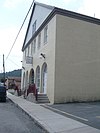Staunton spectator, Staunton Spectator and Vindicator, and Staunton Spectator, and General Advertiser
Located in in Augusta County, Staunton was the geographical center of Virginia prior to West Virginia becoming a state. Known as the "Queen City of the Shenandoah Valley," Staunton is famed for its Romanesque Revival architecture and was fortunate to avoid burning during the Civil War. The Staunton Spectator and the Stauton Spectator and Vindicator have an intriguing history spanning nearly a century. Published weekly from 1823 through 1916, save for a few months, the papers covered much local news and witnessed dynamic changes during their tenure. Most notable were the splitting of the Union and the coming of the Civil War. The Staunton Spectator gained its name from Kenton Harper in 1823. Harper purchased the Republican Farmer from Isaac Collett, who had obtained the paper from its founder, William Lyford, shortly after its establishment in 1809. Harper was from Chambersburg, Pennsylvania, where he learned the newspaper business from his father who published The Franklin Repository. The Spectator was conservative, publishing from the political perspective of the Whig Party.
In 1848, Lyttleton Waddell and his nephew Joseph Addison Waddell purchased the Staunton Spectator. In his memoir "Home Scenes and Family Sketches" J. A. Waddell wrote, "my efforts to instruct and entertain the readers of the Spectator were certainly incessant and untiring." Waddell also commented on the management of the paper: "For a full year, Lyttleton and I did all the job work for the establishment. My editorial labors were performed principally at home, after night." On May 29, 1860, Joseph Waddell and Lyttleton Waddell's successor, Lyttleton Waddell Jr., relinquished control of the paper to Richard Mauzy. In his debut as sole editor and proprietor, Mauzy affirmed that he "will endeavor to preserve the reputation which the paper now possesses for dignity, truthfulness, sound morality and wise conservatism." An opponent of secession, Mauzy believed that there "exists no incompatibility between the Union of the States and the rights of the States." In fact, the Spectator witnessed the demise of the Whig Party and the dissolution of the Union. In his farewell editorial to his patrons J.A. Waddell commented, "In the political world, which has been our peculiar element, parties have sprung into existence, run their careers and passed away. We have witnessed the dismemberment and decay of the glorious old Whig party. Our heart's desire is, that this great and patriotic movement may be crowned with success."
On June 7, 1864, Union troops broke into the three-story building that housed the Spectator, destroyed the office, and threw the presses and type into the street. With the type destroyed, Mauzy was unable to publish until after the war. (In contrast, the rival Staunton Vindicator hid its printing press from the Union forces and within hours of the troops' departure printed a new issue of the newspaper.)
Richard Mauzy published the Staunton Spectator for more than 35 years, presiding over Staunton's evolution from a town to a city. On December 4, 1895, Mauzy turned editorial control over to Rudolph Samuel Turk, bidding farewell to his readership, "As 'Old Uncle Ned' had to 'lay down the shovel and the hoe'-the implements of his vocation-so we now lay down those of our vocation-the lead pencil, the scissors, and the mucilage brush-to take a long desired and much needed rest. We flatter ourself, however, with the belief that we have-what we value more than fortune-the esteem, respect, confidence, and good-will of the community in which we have so long lived."
Two years later, the editor of the Staunton Vindicator, William H. H. Lynn, retired and sold his paper to Turk, wherein Turk merged the two newspapers under the name of the Staunton Spectator and Vindicator. Several Virginia newspapers heralded this merger: The Rockingham Register in Harrisonburg applauded this merger, observing that "It will give Staunton and Augusta County one of the strongest newspaper establishments in the Commonwealth and the Democratic Party an influential and widely-read organ." R. S. Turk continued to publish the Spectator and Vindicator through 1916.
Provided by: Library of Virginia; Richmond, VA
.jpg)






















